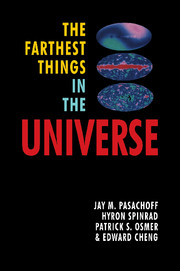CHAPTER FOUR - Galaxies at the limit: the epoch of galaxy formation
Published online by Cambridge University Press: 04 August 2010
Summary
The technical ability of astronomers to obtain images and spectra of very faint galaxies has improved greatly over the last decade. Since galaxies are vast collections of gas and stars, they must physically evolve with time. We should be able to directly observe the time-evolution of galaxies by studying very distant systems; the look-back internal corresponding to the mostdistant galaxies known in 1992 now approaches 15 billion years (80% of the total expansion age of the Universe)!
The line spectra of these faint galaxies are invaluable for redshift determination and physical study. The realization that Ly α (121.6 nm), formed in neutral hydrogen gas, is a strong emission line in most active galaxies and perhaps normal star-forming galaxies also, has helped us measure much larger redshifts in 1987–92 than was previously possible. Recall that this wavelength is in the ultraviolet; it can be observed only by satellites. But when galaxies are very far away, their Doppler effect shifts this spectral line into the region of the spectrum that we can observe with large telescopes on Earth. The largest redshifts for radio galaxies now approach z=3.8. Differing selection effects control which galaxies can be seen/isolated that far away. At least some red galaxies must form at redshift zf>5 (where the subscript f stands for the epoch of star formation).
- Type
- Chapter
- Information
- The Farthest Things in the Universe , pp. 77 - 96Publisher: Cambridge University PressPrint publication year: 1994



